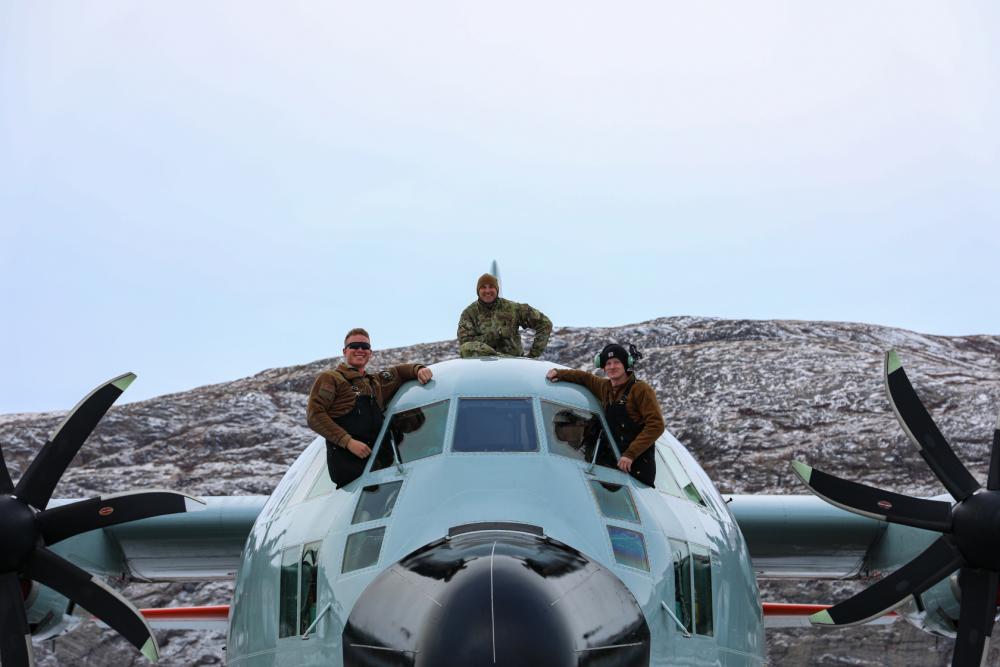[ad_1]
KASSERLUSSEQUA, GREENLAND – Thirty-four New York National Guard Airmen from the 109th Airlift Wing and the 106th Rescue Wing teamed up with Denmark’s Joint Arctic Command during a search and rescue exercise at the Greenland from November 3 to 9, 2021.
The 109th Airlift Wing, based at Stratton Air National Guard Base outside of Schenectady, New York, deployed an aircraft equipped with LC-130 skis and 17 people, while the 106th Rescue Wing, based at Gabreski Air National Guard Base at Westhampton Beach on Long Island, deployed an HC-130J search and rescue aircraft along with 17 personnel.
The 109th Airlift Wing, which operates the world’s largest aircraft equipped to land on snow or ice, operates regularly in Greenland, supplying science facilities at Kangerlussuauq International Airport in Greenland.
The search and rescue exercise, known as Arctic Light, included elements of the Royal Danish Air Force, the Danish Special Operations Command and the Danish Joint Rescue Coordination Center , who is responsible for search and rescue operations in Greenland.
Greenland is an autonomous part of the Kingdom of Denmark, therefore the Danish army is responsible for the defense of the island.
The exercise focused on the ability to activate, deploy and redeploy capabilities in the Arctic, according to Maj.Christopher Husher, the 109th’s principal exercise planner.
Upon arrival in Greenland, the units were assigned tasks from Joint Arctic Command to assist with the search and rescue mission.
The training scenario called for Danish personnel to conduct ground operations following a tsunami that hit Qoornoq, located on the northeast coast of Greenland.
The mission of the New York Air National Guard contingent was to drop supplies to Danish troops on the ground, Husher said.
“We were essential to operations for this exercise,†said Husher. “We made three drops between the 109th and the 106th, consisting of survival rations, equipment and tactical material. We even dropped a boat for Danish search and rescue personnel.
His plane dropped an inflatable boat, better known as the Rubber Combat Craft, or CRCC for short, along with snorkeling gear and rations, Tech said. Sgt. Logan Brennan, a loadmaster with the 109th Airlift Wing.
The boat was dropped onto a combat consumable platform, a fancy term for a pallet designed for one-time use when dropping non-standard loads, Brennan explained.
“The importance of the drops was that we were able to showcase an underutilized skill set for us as loadmasters and a capability for the 109th as a whole,†said Brennan.
“The lots that we have abandoned, including the CRCC, are things that we are trained to handle and rig, but we don’t necessarily have the opportunity to work regularly,†he added.
Danish personnel operated the drop zones, carried out investigations and searched for “survivors” of the tsunami.
“The hardest part in conducting multinational exercises is breaking through the communication barrier,†Husher explained.
“Something as simple as sending out a drop zone statement or reading an air mission order instantly becomes a huge task when electronic systems are not communicating with each other,†he said. declared.
“Exercising this capability and continuing to operate in a joint environment with our allies will not only improve our ability to work together, but will foster better working relationships for the future,†added Husher.
Since 1975, the 109th Airlift Wing has operated in the Arctic, cooperating with entities like the National Science Foundation, as well as with strategic partners like Canada and Denmark.
As the geopolitical landscape changes and operations in the region become more frequent, concerns about interoperability between partners in support of mission effectiveness and security become increasingly important, a said Husher.
In June 2019, the Department of Defense updated its Arctic Strategy to deal with a changing Arctic security environment as the opportunities for international competition in the region begin to increase as the Arctic seas become more navigable in due to climate change.
The DOD has established three pillars to support its desired Arctic end state: raising awareness of the Arctic, improving Arctic operations and strengthening rules-based order in the Arctic, Husher said.
“Arctic Light directly contributes to DOD’s vision for the region,†Husher explained.
“Whether it’s a shot down over the ice cap, a ship sinking in the fjord, or some kind of international conflict; the capabilities and techniques that have been used in Arctic Light will be an integral part of any circumstance that we or our allies will encounter in the Arctic.
“Opportunities like this build trust and operational familiarity between partners,†he said.
| Date taken: | 12.01.2021 |
| Date posted: | 02/12/2021 10:50 |
| Story ID: | 410309 |
| Site: | KASERLASSAQUE, GL |
| Hometown: | SCHENECTADY, ​​NY, United States |
| Web Views: | 67 |
| Downloads: | 0 |
PUBLIC DOMAIN
This work, NY Air Guard supports Danish forces in Greenland training mission, through Sgt Jamie Spaulding, identified by DVI, must comply with the restrictions indicated at https://www.dvidshub.net/about/copyright.
[ad_2]

